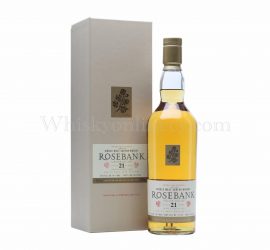The stills of the Rosebank distillery fell into indefinite silence in May of 1993. More recently, in 2002, the British Waterways Board and Westpoint Homes acquired the site. The distillery lay near Falkirk in Stirlingshire, at the Forth and Clyde canal, which joins Glasgow with Edinburgh. Rosebank was a Lowland distillery and, as such, practised triple distillation with one wash still and a pair of spirit stills.
There had been distilleries operating under the name ‘Rosebank’ as early as the late eighteenth century. The Stark brothers had built a distillery at Laurieston, but moved to Camelon due to the lack of a good water source. The Camelon Distillery was opened in 1827, closing less than a decade later. The Rosebank whisky distillery was founded in 1840 by James Rankine who converted the maltings from Camelon distillery, which stood on the site prior. The distillery was named for the flowers which grew on the canal’s banks. His son, R W Rankine took over and completely rebuilt the buildings in 1864.
Blenders favoured the Scotch whisky produced at Rosebank and demand was so high that, during the 1890s, sales were on allocation and, whilst the customers waited, warehouse rent was charged. The Pattison Crisis, at the turn of the nineteenth century, hit the distillery hard and it was left reeling. In 1914, Scottish Malt Distillers acquired Rosebank, latterly becoming part of Diageo. Closing for the First World War, Rosebank conversely remained in operation during the Second. It is still possible to find official bottlings of single malt whisky from the distillery and there have been a handful of independent releases as well. In October 2017 Ian Macleod Distillers announced it was to revive Rosebank, having purchased the trademark from Diageo and the site from Scottish Canals.
Showing the single result





